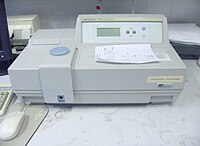
Photo from wikipedia
Precisely controlling the size of engineered biomolecules and pharmaceutical compounds is often critical to their function. Standard methods for size characterization, such as dynamic light scattering or size exclusion chromatography,… Click to show full abstract
Precisely controlling the size of engineered biomolecules and pharmaceutical compounds is often critical to their function. Standard methods for size characterization, such as dynamic light scattering or size exclusion chromatography, can be sample intensive and may not provide the sensitivity needed for mass- or concentration-limited biological systems. Taylor dispersion analysis (TDA) is a proven analytical method for direct, calibration-free size determination which utilizes only nL-pL sample volumes. In TDA, diffusion coefficients, which are mathematically transformed to hydrodynamic radii, are determined by characterizing band broadening of an analyte under well-controlled laminar flow conditions. Here, we describe the design and development of a 3D printed instrument for TDA, which is the first such instrument to offer dual-point laser-induced fluorescence (LIF) detection. The instrument utilized a fully 3D printed eductor as a vacuum source for precise and stable pressure-driven flow within a capillary, evidenced by a linear response in generated static pressure to applied gas pressure (R2 = 0.997) and a 30-fold improvement in stability of static pressure (0.05% RSD) as compared to a standard mechanical pump (1.53%). Design aspects of the LIF detection system were optimized to maximize S/N for excitation and emission optical axes, and high sensitivity was achieved as evidenced by an 80 pM limit of detection for the protein R-Phycoerythrin and low nM limits of detection for three additional fluorophores. The utility of the instrument was demonstrated via sizing of R-Phycoerythrin at pM concentrations.
Journal Title: Analytical chemistry
Year Published: 2022
Link to full text (if available)
Share on Social Media: Sign Up to like & get
recommendations!